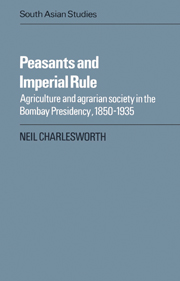Book contents
- Frontmatter
- Contents
- List of maps and tables
- Preface
- Note on technical terms and references
- Maps
- 1 Introduction: the peasant in India and Bombay Presidency
- 2 The village in 1850: land tenure, social structure and revenue policy
- 3 The village in 1850: land and agriculture
- 4 Indebtedness and the Deccan Riots of 1875
- 5 Continuity and change in the rural economy, 1850–1900
- 6 The Bombay peasantry, 1850–1900: social stability or social stratification?
- 7 The agricultural economy, 1900–1935: the critical watershed?
- 8 The impact of government policy, 1880–1935
- 9 The peasant and politics in the early twentieth century
- 10 Conclusions: the problem of differential commercialisation
- Glossary
- Bibliography
- Index
10 - Conclusions: the problem of differential commercialisation
Published online by Cambridge University Press: 10 December 2009
- Frontmatter
- Contents
- List of maps and tables
- Preface
- Note on technical terms and references
- Maps
- 1 Introduction: the peasant in India and Bombay Presidency
- 2 The village in 1850: land tenure, social structure and revenue policy
- 3 The village in 1850: land and agriculture
- 4 Indebtedness and the Deccan Riots of 1875
- 5 Continuity and change in the rural economy, 1850–1900
- 6 The Bombay peasantry, 1850–1900: social stability or social stratification?
- 7 The agricultural economy, 1900–1935: the critical watershed?
- 8 The impact of government policy, 1880–1935
- 9 The peasant and politics in the early twentieth century
- 10 Conclusions: the problem of differential commercialisation
- Glossary
- Bibliography
- Index
Summary
How did Indian agrarian society react to the imperial impact? Why did peasant agriculture fail to be transformed or itself transform the Indian economy? In reviewing these broad issues, the case study of the Bombay Presidency provides answers, which seem superficially familiar. Economic expansion and social change occurred, but they seem to have been accommodated to indigenous systems and structures, altering but not revolutionising them. One fundamental early example of the process at work was the failure of the ryotwari system, despite the intrusive implications of its administrative arrangements, decisively to reshape the existing social structure of most western Indian regions. Ravinder Kumar's conclusion – that ‘by the opening decades of the twentieth century … the villages of Maharashtra were dominated by a nouveau-riche class of Kunbis’ – can be accepted for the central Deccan districts around Poona upon which he focuses: but throughout most of Bombay Presidency long-established office holding elites had survived and even flourished, emerging seemingly more virile from resistance to the administrative drive of the Wingate–Goldsmid settlements.
It was true that the differential impact of British revenue policy had some significant economic consequences. Like the contrast between Jat enterprise and Rajput languor in north India, the distinction drawn between the thrusting, adaptive agriculture permitted by ryotwari arrangements and the economically restrictive atmosphere of talukdari and khoti society perhaps rests on more than simple official prejudice. Agriculture in the khoti south Konkan, for example, despite its intensive methods of cultivation and traditionally high levels of output, failed to diversify and develop a pioneering, commercialised component.
- Type
- Chapter
- Information
- Peasants and Imperial RuleAgriculture and Agrarian Society in the Bombay Presidency 1850–1935, pp. 292 - 300Publisher: Cambridge University PressPrint publication year: 1985

